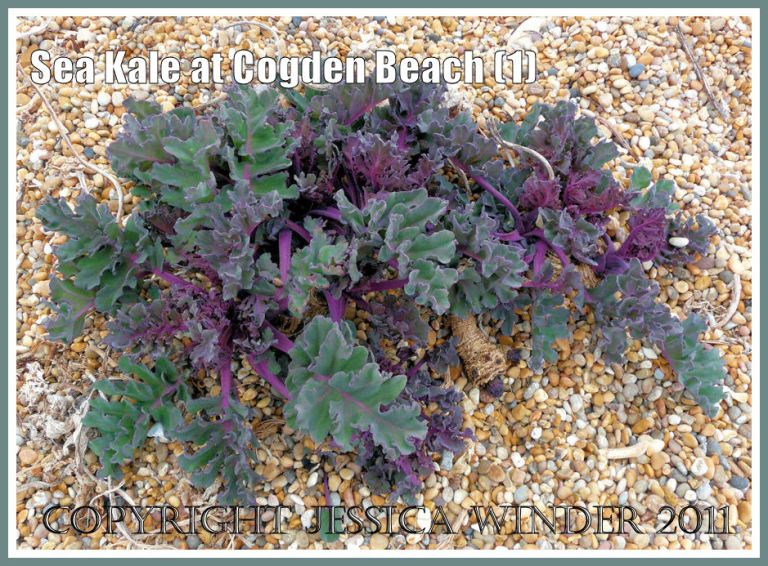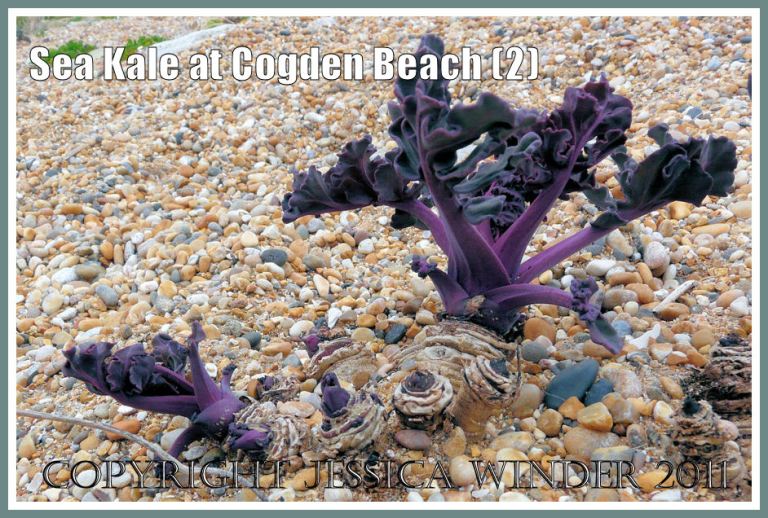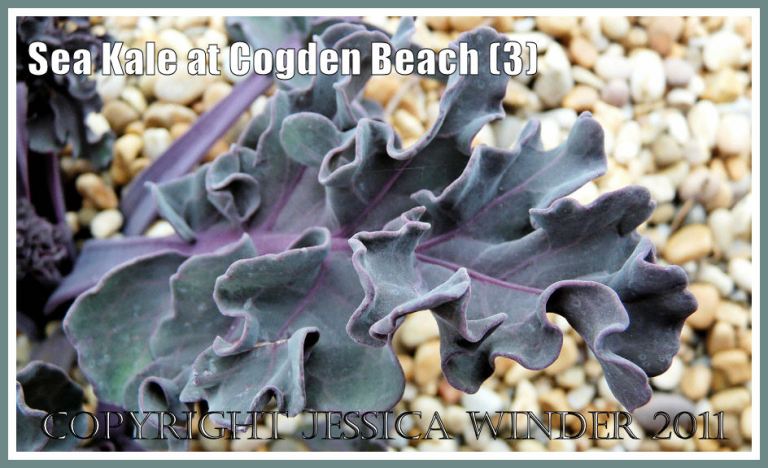There was a veritable vegetable garden on the brow of the shingle ridge at Cogden Beach, Dorset, at the beginning of April. What seemed to be mysterious dark patches on the beach when viewed from a distance, turned out to be the most colourful collection of Sea Kale plants, Crambe maritima Linnaeus. It’s difficult to imagine how something so large and robust could find enough nourishment and freshwater to not only survive but to thrive on a seemingly barren bank of pebbles.
They are actually perennial plants that overwinter underground. I have come across pieces of dried stem with their very distinctive markings on other Dorset beaches without knowing what they could be. When the new leaves start to appear from the old brown wrinkled stems in early spring, they are the most amazingly beautiful deep vivid purple. The fresh curled up leaves look waxy or even velvety. I fear my pictures do not do them justice.
Later the leaves turn green and resemble cabbage leaves. Each new season the leaves grow longer and can reach upto half a metre. When the Sea Kale plant is five years old, it produces flowering branches from May to August smothered with small white flowers. These develop into fruit that generates between 5 – 10,000 seeds. The above ground plant dries and breaks off at the end of the growing period
Sea Kale is a rather rare plant in Britain and on the continent. This may partly be due to the fact that it is delicious and was frequently eaten in times gone by when other fresh vegetables were scarce at the beginning of spring. It is now protected by the Wildlife and Countryside Act (1981) in Britain and by national law in France.
However, it is still possible to cultivate your own if you have the garden space and the patience; or to buy supplies from one of the few specialist horticulturalists. It is grown forced and out of light, rather like rhubarb. The stems are cooked and eaten like asparagus. There are loads of recipes on the Web.
The photograph above shows the new season’s Sea Kale leaves emerging from the (mostly) underground overwintering stems. Below is a close-up view of one of the velvety new-growth curly leaves.
Revision of a post first published 26 April 2009
COPYRIGHT JESSICA WINDER 2011
All Rights Reserved




Hi,
Can you recommend any good online sources for identifying shells found on UK beaches?
Cheers,
Chris
LikeLike
The best all-round on-line source for identification details of marine animals (including molluscs) is probably the Marine Life Information Network (marLIN) which is run by the Marine Biological Association of Great Britain in Plymouth. However, I don’t think it produces a key for identification or offer an identification service – but you could check that out. There are several books that I personally use and these are listed in the Recommended Books page on the blog. On the other hand, if you would like me to have a go at an identification for you, you are very welcome to e-mail the occasional .jpg file to me. I do have some expertise in that area.
LikeLike
Thanks, I find this a very interesting plant. According to Plantlife, “Traditionally sea kale was found – and cultivated – on sandy & shingle beaches, above the high tide mark”.
I guess it’s closely related to our native purple sprouting broccoli, the ancestor of which used to grow wild on the Atlantic coast. The other brassicas that we eat these days like cabbage, kale, cauliflower and (calabrese) broccoli all derive from the Mediterranean.
The photo of the tuber-like root is great. Now I understand how turnips and swede also come from the sea kale family. I’d been wondering about that !
LikeLiked by 1 person